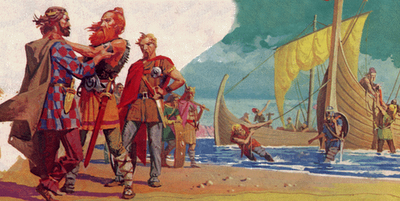The British Isles after Rome Part 2: The Coming of the Anglo-SaxonsRoman citizenship was still a big deal in the 5th Century. It brought with it a certain amount of privilege and a certain amount of status. The Roman administrative structure certainly continued after the troops left. Without the Roman army and its consequent political system, things like administration of local government and, more importantly, tax collection devolved to local leaders.
Roman towns were increasingly abandoned. Notable exceptions were Londinium and Eboracum. Many hill-forts were re-established. Some scholars have suggested that this was more of a gradual shift, perhaps as early as the 4th Century, and that the blending of the peoples was more of a nonviolent one, a sort of cross-population through the years, resulting in a melding of cultures. The most popular interpretation still among scholars, though, is one of conquest. Beginning in the 5th Century, raiders from three Germanic tribes began landing on British lands. These were the Angles, the Jutes, and the Saxons. The Jutes stayed in and around Kent, by and large. The Angles and the Saxons ranged farther afield, with the Saxons doing the most ranging of the three peoples. Together, these three peoples would eventually take over most of the British Isles. The Groans of the Britons have been dated to 446. That was ostensibly a call for help to Rome, in response to an invasion from the north. But other sources say that Anglo-Saxons already living in Britain rebelled in 442. So was the Groans of the Britons a call for help in response to an attack from the south as well? The Anglo-Saxon Chronicle, a set of annals describing the history of the Angles and Saxons in Britain for more than 1,000 years, says that the Britons asked Rome for help in 443 and that, when Rome refused, sent for help to "the Angles." The Chronicle also has an entry for 449 in which the British leader Vortigern invites the Saxon leaders Hengist and Horsa to come help the British fight the Picts. Vortigern is a name that appears in more than one source. Gildas mentions him, as does the 9th-Century monk Nennius, who says Vortigern became the leader of the Britons in 425. Historians still don't agree on whether that was his name or that was his title. Some sources say "the Vortigern." 
Gildas writes that a council was convened and the result was an instruction to Vortigern to go and get some Germanic help, just as the Romans had done in years past. Many foreign auxiliaries had served along Hadrian's Wall and elsewhere throughout Roman Britain. Slavery was a prime source of labor in the Roman realm, and many of those enslaved came from northern Europe. Tradition says that Hengist and Horsa, who were brothers, and a select group of soldiers landed at the Isle of Thanet, off the coast of Kent, with the express purpose of helping Vortigern turn back a northern invasion. And this is what happened, for a time, anyway. Part 3: Desperate Times and Measures |
|
Social Studies for Kids
copyright 2002–2025
David White

 Some things didn't continue, though. Archaeologists have struggled to find coins minted in the 5th Century. Also, the practice of building with stone didn't survive the Roman exodus.
Some things didn't continue, though. Archaeologists have struggled to find coins minted in the 5th Century. Also, the practice of building with stone didn't survive the Roman exodus. 
